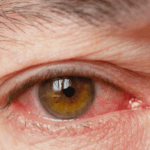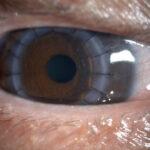Keratoconus is a very serious disease affecting the cornea. The cornea is the clear, outer layer of the eye which functions to focus light rays onto the retina. Keratoconus causes progressive thinning of the cornea. The usual round shape of the cornea thins and begins to bulge into an irregular cone shape.
This abnormal shape prevents light entering the eye from being focused correctly onto the retina causing blurred and distorted vision. The irregular cone may also cause glare and light sensitivity. Visual loss primarily occurs from irregular astigmatism and myopia and secondarily from corneal scarring. Corneal scarring occurs in the advance stage of Keratoconus when the cornea becomes significantly thin causing a tear in the descemets membrane leading to flow of fluid or aqueous into the stroma causing the cornea to swell and thus leaving a scar. This disease typically begins at puberty and progresses till the age of 30. This condition may progress slowly for 10 years or longer. Keratoconus typically affects both eyes, with one being severely affected than the other.
The risk factors are usually those with a family history of Keratoconus and eye rubbing. Eye rubbing is associated with patients who have allergic conjunctivitis or allergic eye diseases. They are quite prone to constantly rub their eyes. This rubbing actually causes thinning of the cornea. Early diagnosis is crucial for patients with Keratoconus. Signs and symptoms of Keratoconus may change as the disease progresses. At an early stage, patients may complain of blurred or distorted vision and an increased sensitivity to bright light and glare. These patients also usually have a large change in refraction over the course of a year. This is usually a 0.50D of myopic change or 1.00D of cylinder change over the year.
If you noticed you need frequent change in your glasses prescription, then you should get your eye checked by an Ophthalmologist.
A cornea specialist would be able to assess your eye and rule out Keratoconus. Keratoconus treatment depends on the severity of the condition and how quickly the disease progresses. Once a patient has been diagnosed with Keratoconus, the next important thing is to prevent its progression. Patients will be advised to stop eye rubbing and any eye allergies should be treated. Surgical intervention such as corneal cross linking will also be advised to stop progression of the disease.






